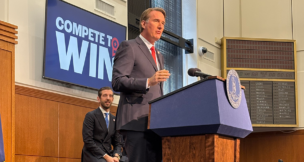
Kate Andrews. Photo by James Lee

Kate Andrews. Photo by James Lee
A letter from the Maritime Guide’s editor
Kate Andrews //April 30, 2025//
The 2025 Virginia Maritime Guide arrives during a period of uncertainty for the United States’ and Virginia’s economies — anxieties primarily driven by President Donald Trump’s slate of tariffs, as well as the impact of potential federal spending cuts impacting the maritime, supply chain, logistics, agriculture and defense sectors, among others.
For the Port of Virginia and associated businesses in the state’s maritime sector — including truckers, ocean shippers, shipbuilders, ship repair businesses, distribution and fulfillment centers, as well as construction companies — leaders are still maintaining optimism that burgeoning tariff wars will be quickly resolved and that defense and military spending will remain robust.
In this year’s executive insights, Colonna’s Shipyard Chairman and CEO Randall Crutchfield says with regard to tariffs and other White House policies, “The only assumption anyone can make is that the international trade landscape will be different 12 months from now.”
And that’s all any of us can say. In the meantime, we hope you enjoy reading the latest on the port’s upgrades at the Norfolk International Terminals, which is nearing completion of its massive, five-year dredging project to make it the deepest and widest harbor on the East Coast, as well as the opening of four major distribution centers in Hampton Roads and Chesterfield County, and Newport News Shipbuilding’s simultaneous assembly of two Gerald R. Ford-class aircraft carriers.
We also check in on the Coastal Virginia Offshore Wind farm, which is still under construction and more than halfway complete off the coast of Virginia Beach. Dominion Energy bumped up its budget from $9.8 billion to $10.7 billion in February, and at the Portsmouth Marine Terminal, construction company Skanska completed a $223 million redevelopment project in March to upgrade 72 acres to create a staging area for CVOW.
As of February, the utility said the 2.6-gigawatt project is now 50% finished and remains on track for completion in 2026. Because the project received all necessary federal approvals during the Biden administration, it is moving forward, despite Trump’s pause on all wind energy initiatives that were awaiting agency approvals.
In closing, I wish to express thanks to the Port of Virginia, the Virginia Maritime Association, CV International’s Rachel Shames, who provided another insightful commentary on the ocean shipping sector, and all of the other Virginia maritime institutions, businesses, experts and executives who make this publication possible.
Kate Andrews
Virginia Business Deputy Editor
















